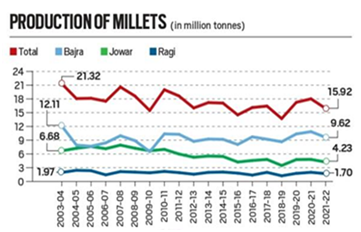

Context
The United Nations has declared 2023 as the International Year of Millets. Despite it having a lot to offer to consumers and farmers, millets aren’t the first choice.
About
What is Millet?
- Millet is a collective term referring to a number of small-seeded annual grassesthat are cultivated as grain crops, primarily on marginal lands in dry areas in temperate, subtropical, and tropical regions.
- Examples: jowar (sorghum), ragi (finger millet), Kodo (Kodo millet), kutki (little millet), kakun (foxtail millet), Sanwa (barnyard millet), cheena (proso millet), kuttu (buckwheat) and chaulai (amaranth).

Positives of millets:
- Nutritionally superior traits:Millet’s score over rice and wheat in terms of minerals, vitamins, and dietary fibre content, as well as amino acid profile.
- For example,Bajra (pearl millet) has iron, zinc, and protein levels comparable to that of wheat, but it’s gluten-free and has more fibre.
|
It can address the problem of “hidden hunger” arising from the consumption of energy-dense but micronutrients-deficient foods. |
- The rotis from bajra make one feel fuller for longer, as they take more time to digest and do not raise blood sugar levels too fast.
Advantages as a crop:
- Millets are hardyand drought-resistant crops.
- This has to do with their short duration(70-100 days, against 115-150 days for rice and wheat)
- lower water requirement(350-500 mm versus 600-1,250 mm) and
- Ability to grow even on poor soilsand in hilly terrain.
|
Indian Agricultural Research Institute (IARI) contribution:
|
Possible Government Intervention:
- The Centre has two existing schemes:
- Pradhan Mantri Poshan Shakti Nirman and
- Saksham Anganwadi & Poshan 2.0 — with a combined budget of Rs 30,496.82 crore in 2022-23.
- These can be better leveraged by making them more millets-focused.
- MSP procurement of milletsshould be part of a decentralized nutritional programme specifically targeting tomorrow’s citizens.
- Centre could fund any state willing to procure milletsspecific to their region exclusively for distribution through schools and anganwadis.
Role of Schools:
- Every schoolchild and Anganwadi beneficiary can be served one daily hot mealbased on locally-sourced bajra, jowar, ragi, Kodo, or kutki.
- It will help combat hidden hunger, besides giving a boost to crop diversification by creating demand for millions of small millets, dairy and poultry farmers.
State Initiatives:
- Odisha already has a dedicated millets missionthat undertook procurement of 32,302 tonnes worth Rs 109.08 crore, mainly of ragi, in 2021-22.
- Rajasthan, Uttar Pradesh, and Haryana might want to do the same in bajra, just as Maharashtra may for jowar, Karnataka for ragi, and Madhya Pradesh for Kodo/ kutki.


